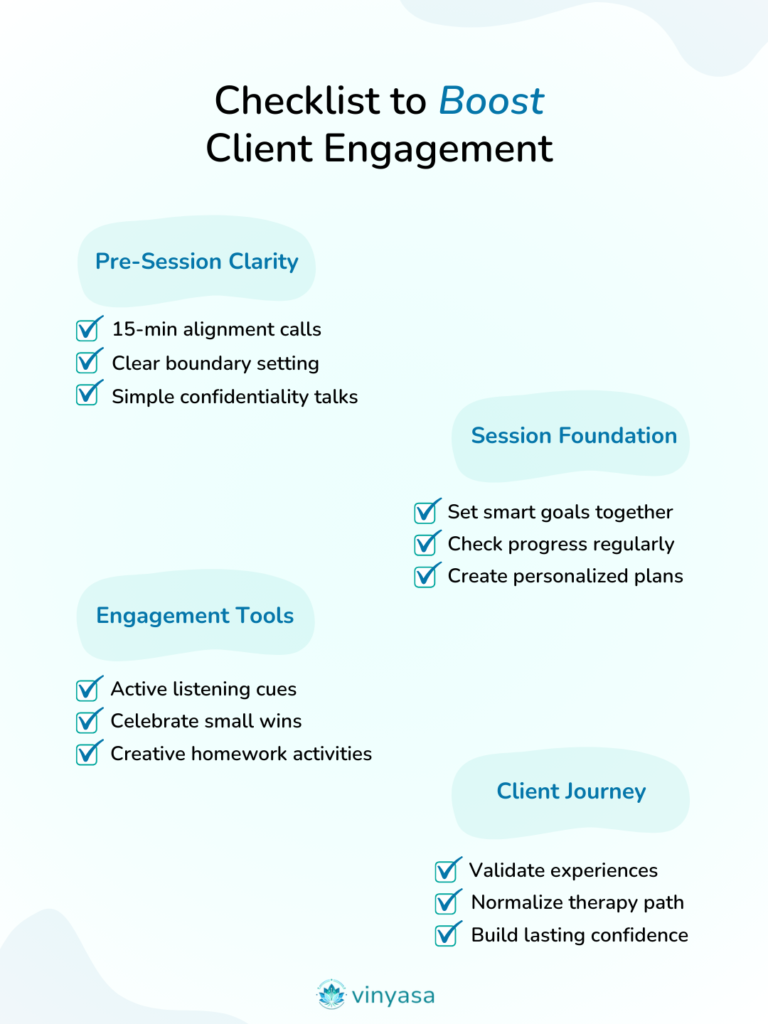Client engagement shapes every moment of therapy sessions. When clients are attentive and committed, they are likely to commit to their goals for future growth.
But let’s be real. Keeping that client engagement in therapy strong today comes with unique challenges.
You’re in the middle of a virtual session when your client’s phone buzzes, and just like that, the connection fades. Or you are struggling to track a client’s progress between sessions. Sure, theory helps, but what you really need are practical strategies.
Let’s explore some real-world client engagement strategies about privacy and creativity you can try today.

Hygiene Checks That Build Trust and Connection
The foundation of great therapy starts with getting the basics right. Here are three hygiene checks to establish trust and set the tone for meaningful sessions:
1. Normalize Therapy for First-Time Clients
First-time clients may feel nervous or unsure. Acknowledge their feelings and create an open, judgment-free space:
- Example: “It’s normal to feel unsure in the beginning. This is your space, and we’ll move at your pace.”
2. Ensure a Professional Virtual Therapy Setup
A polished tech setup reflects professionalism and builds confidence in virtual therapy:
- Stable internet, good lighting, and soundproofing are essentials for seamless sessions.
- Pro Tip: Test your setup before sessions to avoid distractions or delays.
Building Trust Through Transparency and Action
Trust is the cornerstone of every successful therapeutic relationship. It’s earned through intentional, consistent actions that make clients feel safe and respected.
1. Communicate Confidentiality Clearly
- Explain confidentiality policies in simple terms during the first session.
- Example: “Our conversations are private, except when someone may be in danger. If this arises, we’ll discuss it together.”
2. Follow Through on Commitments
- Trust grows when your actions match your words. If you promise to provide a resource or revisit a topic, ensure you follow through promptly.
3. Use Nonjudgmental Language to Encourage Vulnerability
- Example: If a client expresses guilt, respond with: “Thank you for sharing this. Let’s explore it together without judgment.”
4. Respect Client Privacy in Virtual Therapy
- Use HIPAA-compliant platforms like Vinyasa Health to ensure data security.
- Pro Tip: Reassure clients by explaining how their information is protected.
Read more about why privacy-first practice management software is a must for therapists.
Empowering Clients Through Preferences and Feedback
Engagement begins when clients feel heard, valued, and involved in shaping their therapy journey.
1. Start with Their Preferences
- Ask open-ended questions to understand what works best for them:
- Example: “What has been most helpful in past therapy experiences?”
- Personalize sessions based on hobbies or interests. For example, suggest journaling for writers or drawing activities for visual learners.
2. Encourage Feedback to Strengthen Collaboration
- Build feedback into every session with simple questions like:
- “How’s this working for you?”
- Use a 1–10 scale to track engagement, comfort, and progress.
3. Spot and Reinforce Motivators
- Pay attention to what energizes clients and integrate more of these activities into future sessions.
- Example: “You seemed really engaged when we discussed practical strategies—should we explore more of that?”
Establish Clear Goals for Better Client Engagement
Shared goals create structure, set expectations, and give therapy a clear direction.
1. Start with a Discovery Call
- Use the first session to explore challenges and desired outcomes.
- Example: “What would you like to achieve through therapy? Let’s work together to set meaningful goals.”
2. Co-Create SMART Goals
- Develop goals that are Specific, Measurable, Achievable, Relevant, and Time-bound:
- Example: “By next month, let’s identify three coping strategies to manage work-related anxiety.”
3. Revisit and Adjust Goals Regularly
- Therapy is dynamic, and goals may evolve. Dedicate time to review progress and adapt objectives.
- Example: “You’ve made great progress managing stress. Should we focus on improving sleep patterns next?”
Use Active Listening to Build Deeper Connections
Thoughtful, active listening is a cornerstone for improving client engagement in therapy, helping clients feel genuinely heard.
1. Move Beyond Yes-No Questions
- Open-ended questions encourage deeper reflection:
- Avoid: “Are you okay with this plan?”
- Try: “What stands out to you about this plan?”
2. Reframe and Summarize to Show Understanding
- Example: If a client says, “I’m stuck in the same cycle,” respond with: “It sounds like you’re feeling frustrated. Let’s explore what’s within your control to shift.”
3. Leverage Active Listening in Virtual Sessions
- Use small affirmations (“I hear you,” “That makes sense”) to replace nonverbal cues.
- Pro Tip: Use interactive tools like digital whiteboards to co-create session notes and visual aids.
Celebrating Progress to Maintain Client Engagement
Acknowledging progress keeps clients motivated and helps reframe challenges as opportunities for growth.
1. Celebrate Tangible Wins
- Reinforce positive behaviors with specific praise:
- Example: “You’ve been practicing boundary-setting this week—that’s a big step forward.”
2. Frame Setbacks as Learning Moments
- Normalize challenges by showing clients how obstacles can teach resilience:
- Example: “What do you think this experience taught you about managing stress differently?”
3. Track and Reflect on Progress
- Use tools like Vinyasa Health to monitor attendance, participation, and progress toward goals.
- Pro Tip: Dedicate part of each session to review achievements and adjust goals collaboratively.
Adapting Engagement for Different Types of Therapy Clients
Every client brings a unique engagement style. Tailoring your approach ensures a deeper connection.
1. Silent or Withdrawn Clients
- Respect silence as part of their process. Encourage non-verbal tools like journaling or drawing.
- Example: “Would you feel comfortable sketching how you’re feeling today?”
2. Overly Talkative Clients
- Gently steer conversations back to therapy goals.
- Example: “This is great insight—how do you think it connects to what we’ve been working on?”
3. Resistant Clients
- Build trust gradually using motivational interviewing.
- Example: “It’s okay to feel uncertain about this process. Let’s take it one step at a time.”
4. Inconsistent Clients
- Offer flexible options like virtual sessions to reduce logistical barriers.
- Pro Tip: Use Vinyasa Health’s scheduling features to send reminders and simplify follow-ups.
5 Common Mistakes to Avoid for Disengagement
Even with the best intentions, certain missteps can harm engagement. Here’s how to avoid them:

- Regular check-ins help you stay aligned with evolving client goals.
- Reframe feedback constructively to reinforce progress.
- Adapt methods to suit each client’s preferences.
- Use secure platforms and reassure clients of their confidentiality.
- Address early signs like missed appointments or reduced participation.
Conclusion: Build Stronger Connections, One Session at a Time
By integrating these strategies, you’re creating stronger client engagement in therapy, one meaningful session at a time.
Therapy isn’t about perfection but adaptability, presence, and collaboration. Start implementing these tools today and watch your sessions transform.
Ready to simplify your practice and deepen client engagement?
Discover how Vinyasa Health can streamline your workflows, protect privacy, and help you focus on what matters most—your client.

